#danganronpa meta
Text
Hope's Peak and... Whatever is Going on with the "Talents" They Study

Hope's Peak Academy! Where only the greatest talents are invited to focus on the areas in which they excel (and to be studied by the staff).
The people working at Hope's Peak Academy in Danganronpa (whether staff, scientists, or Steering Committee) are pretty consistently presented as being dedicated to researching and understanding the nature of talent. They talk like talent is this hazy concept that only certain people somehow possess, so they're out to crack the code of its mysterious origins.

We have top men working on the origins of talent right now. .... TOP. MEN.
Now, I know we all eventually learn just how much of a shitshow HPA was and how corrupt its primary operators were. But the evidence of their crimes is mostly focused on how they take their interest in "Talent" much too far. So long as it furthered the study of "talent," human experimentation, endangering the lives of students, and much, MUCH more were totally on the table as far as HPA's Steering Committee was concerned. Which is very bad, yes.
However! I think the issues with HPA's intentions ran even deeper. The people in charge weren't just corrupt; they were also stupid. And this is evidenced by many of the "talents" they identified and researched.
See, Hope's Peak makes no real distinction between the types of talent they identify and accept into their walls. Even though there's a MASSIVE DIFFERENCE between the talent of someone like Junko Enoshima vs. that of someone like Fuyuhiko Kuzuryuu. Y'know?
(I strongly doubt I'm the first to observe how bullshit some of these "talents" are. But since I can't find any other conversations about this on Tumblr, I'm going to move forward with making my own commentary. Sorry?)

BTW, consider this: If Komaeda were somehow born earlier and was an adult by the time the 77th Class entered HPA? He could've easily been one of the staff members putting Hajime into that metal coffin.
In descending order of "I can see why they were interested" to "WTF is this," here are the four core types of Super High School-Level "Talents" that Hope's Peak Academy welcomes within its hallowed halls:
(DISCLAIMER: I include V3 students as some of the examples cited below. YES, I know they don't attend Hope's Peak in their game's main storyline. However, they attend Hope's Peak in both UTDP and DRS. That's good enough for me; you can always ignore those examples if you disagree.)
CATEGORY (A) Talents that seem to come innaately/naturally to those who have them. These are either your wunderkind types, or they otherwise gained their talent seemingly overnight. — (e.g., Yasuhiro Hagakure, Junko Enoshima, Nagito Komaeda, Miu Iruma)
My Thoughts: Okay, SURE. I get why you'd want to study how this can happen and where these kinds of skills come from. No notes.
CATEGORY (B) Talents that are developed over a lifetime of practice and/or hard work. Most Hope's Peak students we know about seem like they slot into this category. — (e.g., Nekomaru Nidai, Mikan Tsumiki, Kaede Akamatsu)
My Thoughts: My first reaction is "What is there to study/research about this?" Do the Hope's Peak staff not know that working on something for a long time can make you get way better at that thing? Y'all reminding me of Hajime in the now-classic @reddpenn comic where he is legitimately shocked to learn people can gain skills through practice. :P But HOLD UP; let's give them the benefit of the doubt here for a sec. Perhaps Hope's Peak's personnel are wondering why only some practitioners of these talents can reach such a noteworthy level of skill by the time they're teenagers? That's the most reasonable conclusion to draw about the inclusion of these students.
CATEGORY (C) Talents that are only noteworthy because these students demonstrated some above-average skill relative to their age or because they garnered attention through one specific incident. In other words: These individuals aren't nearly as exceptional as those in the previous two categories of talent, but at least they seem pretty decent at what they're being identifed for? — (e.g., Mahiru Koizumi, Shuichi Saihara, Kaito Momota)
My Thoughts: I hope I'm being clear enough about what I mean by this category. But if not, I'll try to clarify: Shuichi was supposedly recognized for his talent solely because he caught one murderer. Mahiru's photography is almost solely portrait photography and therefore not particularly noteworthy to most photographers; she's just pretty good at the one thing she happens to do. (And in truth, her mom's reputation probably played a role in her own Hope's Peak invite.) Kaito being able to pass a basic Astronaut screening exam at a younger age than is usually allowed is neat, but it's not like he's been an exceptional trainee or even gone into space; he's just the "Ultimate Astronaut" because he cheated his way into taking a test early and did surprisingly well at it. Maybe we're meant to think "Oh, Kizakura or whoever could somehow tell these students have the innate potential to be truly spectacular" or somesuch?? But that interpretation requires putting a lot of faith in this questionable-ass system (and the one HPA scout we're familiar with — a known alcoholic). Do these people REALLY demand further study? Is there ACTUALLY anything to be gained by learning about their "talents"??? I... can't see it, y'all. I don't get it.
CATEGORY (D) Talents that aren't even really a talent at all, they're just a position/title someone gained by being born. — (e.g., Fuyuhiko Kuzuryuu, Sonia Nevermind, Keebo)
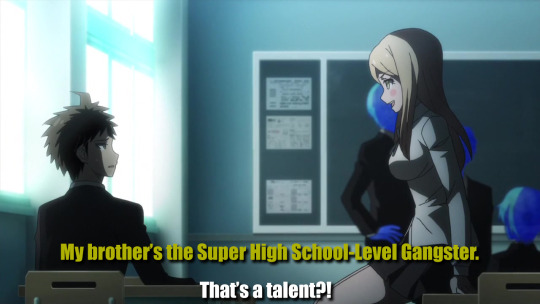
LIVE HINATA REACTION
My Thoughts: Okay, so MAYBE Sonia was recognized by Hope's Peak as the the absolute pinnacle of refinement and royal behavior or something? But I kind of doubt it based on her actual behavior (and weird interest in serial killers) in DR2. And there's no way in hell that Fuyuhiko is the baddest-ass Yakuza, even among teenagers. You scratch that kid slightly. and you get the babychild undernearth. And Keebo? His talent is HIS OWN EXISTENCE. His "talent" is actually just his creator's talent, FFS. He's not even "High School"-AGED in reality; he's just programmed to operate at a mental capacity of approximately teenage-level. So ultimately, I'm asking: What is there to STUDY about any of these?! These aren't even TALENTS, frankly! These have got me wondering if there's some other reason to include these particular students... like perhaps Hope's Peak wants to extend their tentacles into the power/influence afforded by Novoselic royalty/the Yakuza? Or perhaps they wish the leverage Keebo's A.I. technology in their own pursuit of creating of an "Ultimate Talent"? Point is: THESE 'TALENTS' ARE SEVERELY SUS. (I have to wonder if the larger public and Reserve Coursers ever complained about how sketchy some of this shit sounds?? SURELY they did.)
ADDENDUM/NOTE: There are also those who hover between the various categories I've cited. This includes those who might be a mixture of two categories, or those whose background is hazy enough that it's not clear whether they always had their talent (A) or developed it over time (B). But I think the above list encompasses everyone we know about, either in one or multiple categories.
CONCLUSION: Hope's Peak is so vague and weird about what they define as "talents" that it's tough to say what on Earth they believe they're studying over there. Because the methodology they were employing for identifying these talents is super loose, they're inviting over SOME fascinating subjects right alongside a bunch of teenagers who... really can't reveal much of anything about anything?
How did Junko Enoshima learn to easily analyze the patterns all around her to the point that she was able to accurately predict most outcomes? GREAT question! You may genuinely be able to unravel something about inborn skillsets and unusual brain development from such a case.
How did Mahiru Koizumi become a great photographer? Uhhh, she observed some stuff from her mom and just tried a decent amount of portraits, I suppose. But she's not even that amazing frankly, she ain't taking any award-winning pictures or using any particular artistry. She's just good at smiling portraits. That's it. You ain't gonna learn shit from this.
How did Fuyuhiko become the Ultimate Yakuza? Because YOU decided he was! And that was just because of his inherited leadership role! He has NO special talent, wtf are you idiots doing?!?!
ANYWAY, that should cover all of the Hope's Peak students we've ever me—

Oh, right. There's ONE weird half-exception to this list, which I guess I'll explain for anyone who wants to be extracirricular about this topic.
BONUS! Outlier Case: Makoto Naegi (in DR1 only)
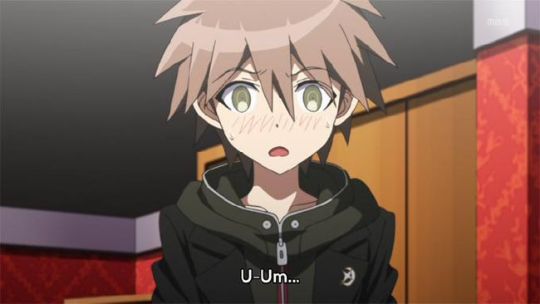
My Thoughts: In the original Danganronpa: Trigger Happy Havoc, the player/viewer/reader is made to believe that Makoto Naegi possesses no talent at all. Instead, Naegi was merely this year's winner of the annual drawing at Hope's Peak, and THAT IS IT. He was just drawn from a proverbial hat, and his presence is just a randomized factor. And SURE, by the end of the game/manga/anime, he's declared the "Ultimate Hope," but it's not like he was brought into the school based on that talent, so that's not particularly relevant. What I'm saying is simply this: DR1-era Naegi is the only known Hope's Peak student who doesn't fit into the above four categories. ............ Though this was later retconned, of course. Stories such as Makoto Naegi's Worst Day Ever (which came out alongside the first release of DR2, a mere two years after DR1 first hit PSP) and Danganronpa 3 would state that Naegi always possessed some unpredictable form of Komaeda-style inborn "luck" even if he wasn't necessarily aware of it. Which slots him into category (A). AS SUCH, he was only an outlier for literally THE FIRST INSTALLMENT OF THE SERIES. And since the first installment didn't really delve as much into the sketchy, obsessive ways the Hope's Peak scientists chose to study their roster of "talents," his outlier nature isn't really relevant anyway. I don't feel any need to justify "Makoto Naegi as portrayed in 2010-2011 continuity" for his inclusion in the class roster.
..........................but if I DID have to do that, I'd say including him among the students makes him the Control Group. :P
#danganronpa meta#danganronpa#danganronpa longreads#longreads#longread#personal essays#dr1 spoilers#dr3 spoilers#dr2 spoilers#drv3 spoilers
52 notes
·
View notes
Note
How do you think Makoto`s and Nagito`s luck work?
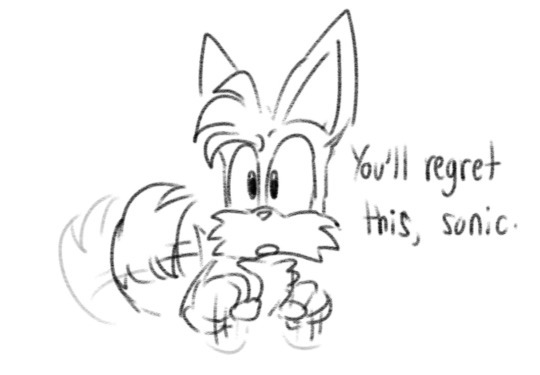
*deeep breath*
*Slams my ruler onto the whiteboard* ALRIGHT
To understand Makoto and Nagito's luck, we must first understand Luck in the Danganronpa universe.
First off their are multiple types of luck, and not all luck talents are built the same. That's the first thing you need to understand, every luck talent is a unique personal talent to each individual. Luck talents can't really be compared because they're so different from each other and can even create other talents.
Case in point the true second luck talent we had in the series...CELESTIA LUDENBERG. While not the ultimate lucky student, her gambling talent is NEAR COMPLETE LUCK, something she FREELY ADMITS.







While this kind of thinking is more associated with Komaeda, it is actually CELESTE who first brings up luck as something beyond just chance, but instead as something more akin to religion. She even compares it to fate, Celestia will tell us in her FIRST free time event exactly what she thinks of luck. Which correlates well with Komaeda’s thinking. First of all the immutability of it, that you are simply born with that luck and nothing can ever change it, then there is the thought there is no inbetween luck it is only Good luck or Bad luck and it’s those two things that determine basically everything. Celestia and Komaeda have a very similar worldview, the only difference is the fact Celeste’s luck is only good and has such given her a much more positive view of it. Celeste seems to have spent a lot of time thinking about luck, and has a lot of faith in it, seen how in another free time events despite not knowing how to even play, she won a Shogi gambling competition.


While Celeste has a habit of exaggerating and dramatics, I think she’s telling the truth about this story, it matches up with her beliefs after all. No skill or talent carried her through to the end and to victory, just pure luck, her gambling luck that is the basis of her talent.
From this we learn that luck talents are much broader then just ‘lucky student’ and can make up a lot of different talents based on how it presents themselves with everyone having unique sets of luck and activation requirements. With both her and Komaeda sharing similar views on luck, it’s clear that those with lucky talents tend to find luck to be immutable and simply just a piece of ones self that can never be changed. Luck is everything to those with powerful enough luck, to the point it becomes almost blinding and overshadows skill, though Celeste seems to feel a bit ashamed that she didn’t at least make an attempt at having skill at Shogi. A little dog can’t become a big dog, and someone with bad gambling luck can never have good gambling luck and vice versa.
This isn’t true.
As you may have noticed if her gambling luck is that good that it overrides skill completely, then how did she lose? By how her talent works as long as it’s a gamble, she wins. Period. Nothing to be done about it. How did she lose the gamble of her life?
Easy, Makoto’s luck works as a luck nullifier.
You may be asking what the hell I’m talking about and I redirect your attention to the short story of Makoto Naegi’s Worst Day Ever.
“People often say that men are defined by their names, and indeed, in his thirty-two years on Earth, Jutarou had never once thought of himself as unlucky. In fact, he had been blessed with abnormally good luck. By the very nature of his work, he had found himself in a number of dangerous situations in the past, but every time—without fail—a series of fortunate flukes guided him to safety.
While his luck could be considered one of his strengths, he wasn’t fond of admitting it.
Rather, allowing himself to end up in situations where the outcome was in fate’s hands was unacceptable to him. He knew good and well that, in his line of work, even the smallest of slip-ups could mean disaster.
Jutarou was a thief.
The most important thing to him when he was on a job was reducing the potential influence of forces outside his control—luck, other people—to an absolute minimum. In his mind, a thorough, well crafted plan was the cornerstone of any job. He always formulated and executed his plans by himself, and any job for which that wasn’t possible, he wouldn’t take. There was nothing worse than being betrayed by a partner who let his greed get to his head, and besides, Jutarou didn’t need anyone slowing him down. And he especially didn’t need to be asking for help from on high.
Naturally, his current job was no different. He had planned everything and put that plan into action all by himself. His target had been a small jewelry store in a nearby shopping district. Jutarou had received information that, despite looking run-down, the store had a hidden stash of extremely valuable jewels. And to top it off, the owner was a bit of a penny-pincher, so security was light.
It was an incredible opportunity—the kind that you only ever got once or twice.
So Jutarou crafted an intricate, but bold, plan, and then he went through with it. Naturally—as far as he was concerned—everything went without a hitch, exactly as it was supposed to. His plan was perfect, leaving no room whatsoever for outside interference. And there had been none.
Spoils tucked away in his bag, he calmly stepped onto the bus. Jutarou liked to make use of public transportation as much as possible while on a job. It was easier to blend into the crowd in a bustling city by riding a bus or train than it was driving a car or motorcycle, and by dressing like a businessman on the job, he practically disappeared.
The disguise worked, too. Not a person on that bus gave him a second look as he took an open seat at the front.
Finally certain he had completed his work, Jutarou let out a small sigh of relief. As the bus vibrated gently beneath him, he silently basked in the satisfaction of a job well done.
And then, a sick twist of fate made quick work of everything he had accomplished. Only, it wasn’t his luck that laid everything to waste—rather, he was just caught in the crossfire of some teenage boy’s misfortune. Some boy who just happened to climb onto the same bus as him. It was a stroke of bad luck so overwhelming that even Jutarou who, up to that point, had been blessed with such incredibly good luck, was helpless to prevent it”
Meet Jutarou who appears to have a luck talent of his own, the main antagonist in the short story. While he doesn’t like purely to rely on it, he notes that he is a very lucky man and multiple times in the story comments about how his luck never fails him. Until it does. Makoto Naegi’s bad luck was so strong, it had OVERRIDDEN his good luck, giving Jutarou bad luck to give Makoto WORSE luck.
This trend continues throughout the story, despite Jutarou’s best efforts and best luck to get himself not arrested, Makoto’s sheer bad luck is enough to dissuade EVERY attempt as the situation only gets worse and worse for Makoto until it ends up with the groceries that Makoto was ORIGINALLY SENT TO GET ending up basically exploding.
This incident directly leads into Makoto getting into Hope’s Peak, as his luck is SO BAD that in that same explosion the original lottery winners invitation gets destroyed and they do a new drawing, this time pulling Makoto’s name.
Luck talents have no effect on Makoto because his luck counteracts it, it doesnt matter how good your luck is, if Makoto’s luck wants to involve you, you have no control over the luck in the situation anymore. From this we learn Luck talents interacting with each other can have odd effects, especially if Makoto is involved.
There is a second piece of evidence that Luck talents aren’t quite as straightforward as “you’re born with it” and his name, is the mortal god himself, Izuru Kamukura
As Hajime Hinata, his luck is well, it’s not great, but I wouldn’t call it bad either. He’s average, very plainly average. Then he got a lobotomy and became Izuru, and suddenly something has changed. Izuru DOES have good luck, and he has an intense amount of control over his luck that he can even can beat Komaeda in a gun fight. Which means not only is Luck a real talent despite how Komaeda bemoans, it has some way to quantifiably measure and implant it as his Luck talent is just as artificial as the rest of his talents. Luck isn’t just chance or fate, it’s a legitimate part of someones body that can be implanted into someone else with the right tools. Which is, SO MUCH TO UNPACK.
We don’t learn HOW they implanted luck, so we can only guess where luck resides within a human body. Wherever it is though, this implies while people are indeed born with a specific luck pattern that is otherwise immutable this pattern can be tampered and changed by an outside source with the right know how. Celeste is essentially correct in the fact humans are born programmed with the luck they have, but we lack the specifics. I am pointing a gun at the hope cultivation program if you’re going to break the geneva convention at least LET ME KNOW how you implanted fucking LUCK!
Luck is beyond just how we view luck in our world, luck is an inherent part of them, I’d dare to even call it another sense. Like a sense of sight or sense of direction, everyone has a sense of luck. Some don’t have much of it, some of them have little, and some of them have enough of it that it almost seems like a magical power.
Of course now that we have a loose understanding of how luck just works in this setting, this tells us little on how luck works for those two specifically.
Makoto’s luck is known to be the most confusing even in universe, as his luck is a liar. Bad luck often is good luck often is bad luck. It is impossible to tell if something is good or bad when it comes to his luck until like three years later after all the dominoes and butterfly effects have mostly settled. Celeste says there is no in-betweens but Makoto’s luck LOVES its grey areas. Making things be both bad and good at the same time, Makoto’s luck cannot be divided into good or bad because it’s always both at the same damn time. The only think about his luck that’s in any way clear is that it refuses to let him die. No matter how bad his luck seems, the moment he could genuinely die, his luck swoops in to grab him from the brink.
Like yeah he lived thats good but now he has trauma and thats bad and now he can help and thats good but that helping is also being used as propaganda and that’s bad. Makoto lives in a state of greys, his luck refuses the black and white views of Celeste or Komaeda, everything his luck does will be both bad and good, creating mostly just confusion. It’s easy to see how Makoto just kinda shrugs it off as just unfortunate and moves on with his life, his luck keeps trying to be good and bad at the same time.
Then there’s Komaeda, who has only bad luck. Which you may be saying “what? But his luck can be good!” and I ask you how good his luck really is? His luck constantly kills the people around him and even killed him. Sure sometimes he gets paltry rewards like money or freedom, but in reality, the scales are NOT balanced. An inheritance can’t make up for dead parents, winning the lottery doesn’t erase the trauma of being kidnapped.
Even moments where his luck seems to work in his favor only makes him miserable, winning russian roulette wasn’t a triumph or good luck for him really, it only drove him insane.
If I had to name Komaeda’s luck I’d go for something like short term benefits with long term consequences. The bad effects of his luck always echo farther and go on for longer then the good effects which are often quick distractions or quick victories. However Komaeda lets himself settle for this, pretending like the scales actually have any meaning, letting himself have bad luck and thinking the small rewards of it measures up to the sheer amount of bad luck it took.
Komaeda’s luck can give him the things he needs in the moment, but there is always consequences for it’s use. Komaeda pretends like it's an equivalent exchange, but actually looking at, even the 'good' parts often brings him suffering. Like yeah he's rich and has freedom, but he's lonely and unable to connect to people. Even the best parts of his luck are only good short term before also becoming more akin to bad luck.
His luck is basically a deal with the devil, he receives pain and suffering, and he receives... a whole bunch of sodas! Just ignore the fact the scars will last longer then the soda and you can pretend it all balanced out.
It’s easy to see how he fell into the viewpoints he did when he basically has to lie to himself to make his luck more tolerable or seem fair. Especially because unlike Makoto's, his luck seems perfectly willing to kill him if he's not careful.
Of course these are only my current views on their luck cycles, my mind and thoughts are CONSTANTLY changing on this, because it’s just, so nebulous. One of these days I’d love to do a luck deep dive on all the characters and see what other talents are secretly luck talents.
#LUCK IN DANGANRONPA THE FUCKS YOUR DEAL#makoto naegi#danganronpa meta#trigger happy havoc#goodbye despair#danganronpa 3#meta#goodbye despair meta#trigger happy havoc meta#danganronpa 3 meta#musings from the music manager#nagito komaeda#celestia ludenberg#izuru kamukura#hajime hinata#anon chaos
128 notes
·
View notes
Text
I don’t think Hajime and izuru were ever different people, really. I think Hajime was already prone to moodiness and being at bit morose. When we see him at the beginning of D3 he’s already struggling with apathy and boredom. It’s only once he meets Chiaki that he finds some inspiration. And Hajime/Izuru both seem to believe that talent makes you important. It just happens that belief fuels Hajime’s self loathing and Izuru’s god complex. I think Hajime’s attachment to Chiaki, his classmates, and the world as a whole was the only thing keeping him from being a constantly sighing uncaring asshole, so when they took his memories that’s what he became. I think once he wakes up and remembers he can feel again, but I think it’s all muted.
#basically I’m diagnosing Hajime with depression srry bud#hajime hinata#hinata hajime#izuru kamakura#kamakura izuru#danganronpa#danganronpa sdr2#danganronpa 3#danganronpa meta#his depression makes him apathetic and mutes everything#without anyone memories he gives in to that apathy completely#hi here’s my Ted talk about how Despair is a metaphor for letting depression control your life#despair is when you give into your most toxic and destructive urges#for Hajime it was apathy and they took away his defense
55 notes
·
View notes
Text
Who is Afraid of Whom?
Subtitle: Korekiyo is an unreliable narrator
Read as: Please for the love of god stop taking everything Korekiyo says at face value and be willing to look at the Shinguuji's dynamic with a bit more complexity instead of blaming Miyadera for everything.
I've teased this for a bit but I've been working on a very long meta write up of a reading of these two following the canon text as much as possible while providing my own insights. This is Part 1 of X (I'll update this when I finish this series and add links as I continue.)
Content warnings for discussions of abuse and incest.
To begin, I understand that this is a controversial topic. If you believe Korekiyo to be the victim of years of abuse, whatever I write here will probably come off as heartless apologism for the “worst Danganronpa character.” I hope that if this analysis at any point causes you genuine emotional distress or discomfort that you just close it. If you choose to continue reading it, then I hope you can give me the benefit of the doubt for where I’m coming from and save any judgment for the end.
For the sake of simplicity, I am going to be referring to Korekiyo’s sister by the fan name Miyadera. I unfortunately do not know which individual deserves the credit for this name as it was coined back before the localization, but I do know it is an alternate reading of the characters in Shinguji, 真宮寺. 宮 is Miya and 寺 is tera.
宮 could be literally translated to palace or shrine, but is usually only reserved for Shinto shrines. 寺 is used only for Buddhist temples. I have a post explaining more about this [here].
I’d like to start by debunking what seems to be a rumor/misreading of the text that has become canon to many people. Many fans I’ve seen believe Korekiyo is the only victim in the dynamic or that he is afraid of his sister. What is provided for evidence is usually how nervous Korekiyo seems during the trial once he’s on the ropes and the tulpa manifests.
On that note, I want to clarify that I will be referring to the Miyadera that speaks through Korekiyo as a tulpa. I have seen some interpretations that treat their situation as more like a dissociative disorder, but I will not be touching on that or give that reading any credibility as I find it to be a bit disrespectful. The killer/villain with dissociative identity disorder is also a bit of an overplayed trope.
If you’re not familiar with what a tulpa is, I’ll provide a very simplified definition here. If anything I say seems to be unclear, you’re free to do your own research. If I get anything wrong, please don’t hesitate to correct me!
Tulpas have a Buddhist origin and were believed to be a manifestation that guides someone who has not reached nirvana yet. The simplest way to describe them would be as a spiritual guide.
Other forms of tulpas are not from one specific religion and have a connection to theosophy.
Theosophy is another very complex concept that I’ll simplify as a belief in a spiritual reality/separate realm that can be reached through meditation, revelations, or other states of heightened awareness and or emotions. These tulpas are believed to be connected to or have come from this other realm.
The final type of tulpa I’d like to discuss is a significantly more modern concept and is connected to groups that refer to themselves as tulpamancers. For people in this group, a tulpa is completely divorced from all spirituality and is treated more psychologically. These manifestations are much more deliberate as these individuals try to create tulpas of one specific person. It is usually done to cope with loneliness or other problems like anxiety. There are also instances of people claiming to have had romantic or sexual interactions with their tulpas.
I believe the writers took inspiration from all potential manifestations of tulpas when they wrote the Miyadera tulpa. The most modern take and tulpamancers probably had the most influence.
Korekiyo does share his experience of when the tulpa of his sister first manifested, but I would like to look into that in detail later. I plan on discussing all information about Korekiyo and Miyadera that’s revealed in FTEs, Salmon Team, and other similar events in the same section.
Back to Korekiyo’s fear, the insistence that Korekiyo is afraid of Miyadera and even the tulpa of her never seemed to click for me. Chapter 3, especially the trial, are the parts of Danganronpa V3 I am the most familiar with. Korekiyo is most certainly panicking when his plans are unraveled, but none of that fear seemed to be caused by the presence of the tulpa. He is also able to relay his story about Miyadera after the trial with perfect clarity. For people who read Korekiyo as a victim, this probably doesn’t seem like solid proof. His erratic behavior and validating his experience could just be seen as a trauma response.
In order to refresh my memory, I decided I’d be revisiting the trial and the scenes that follow it. I will not be looking too deeply at the first half of the trial since the tulpa has no presence, and Korekiyo does not reference his sister at all. A lot of this analysis is being done as a reaction to replaying and rewatching content in the game so my takes will be fresh.
If I need to revisit the first half of the trial for parts later in this analysis, I will do so.
Korekiyo’s calm facade finally breaks once it becomes obvious that admitting he murdered Tenko put him into a corner and also implicated him in Angie’s killing.
Korekiyo's specific quote when the tulpa cuts in is “I will not fear. I will not back down.” The tulpa is then revealed. I specifically attribute the above quote to Korekiyo and not Miyadera because it’s not spoken in the voice that is used for Miyadera in the rest of the trial.
I have heard that it is easier to tell the two apart in the original Japanese text because they have different speaking styles, but I’m not familiar enough with Japanese to cite too much from the original text. I don’t want to potentially muddy the waters due to a mistranslation on my part. Thankfully, for the rest of the trial, it’s usually very clear which one of them is speaking.
The first instance of the Miyadera tulpa appearing is when Korekiyo is under extreme stress, and her main goal is to help bring him down from this intense emotional state. It’s the first thing she does before addressing anyone else in the trial.
If I was a bit less diligent, I’d stop this section here and say the argument that Korekiyo is afraid of the tulpa is debunked. However, I’d like to be as thorough as possible so we’ll continue on with this topic.
Miyadera’s words encourage Korekiyo to keep arguing for his innocence in the murder case. The rebuttal that follows is done by Korekiyo alone.
Miyadera appears once again when Korekiyo’s rebuttal isn’t enough to prove his innocence, and they have definitive proof that he murdered Angie.
The lines that follow are somewhat controversial, and they are the ones I believe are misinterpreted the most often. Miyadera says:
“You mustn’t raise your voice. You mustn’t stutter. You mustn’t lose composure. You mustn't become flustered. You mustn’t waver.”
For some reason, this is seen as Miyadera scolding Korekiyo and as clear evidence that she abused him in the past. However, in the full context of the scene, it’s pretty obvious that Korekiyo is losing the ability to argue for his innocence without panicking. Miyadera is reassuring him that he doesn’t need to worry about everyone else in the trial, calling them a “sorry lot”.
Miyadera is saying that as long as Korekiyo remains calm then he should be able to make an argument that will prove he’s not guilty. Her appearance is only for his benefit as he is able to continue speaking more concisely each time after she speaks.
Once he gets back on his feet, Miyadera gives him further encouragement and praises him.
One could argue this is an instance of emotional manipulation (though I’d have to wonder why she would be manipulating him for an outcome that’s in his best interest. We can return to this later), but I believe it does prove that he is not afraid of her. Without her encouragement, the latter half of the trial would have been significantly shorter. I doubt Korekiyo would have been able to argue for his innocence with the panicked state he was in.
The next scene is another line I see as being wildly misunderstood to the point where I wonder if anyone discussing it has actually seen it in context.
In a lot of fanworks, for some reason, “Come on, apologize” is treated as something Miyadera has said to Korekiyo as another instance of scolding him or pushing him into a corner. Though it’s pretty clear in the context of the scene that Miyadera is angry at Shuichi and tells him to apologize for continuing to accuse Korekiyo.
During the argument armament, Miyadera continues to encourage Korekiyo during his final pleas for his innocence. Even the final point that Shuichi has to prove wrong is her defending him.
I will admit that Korekiyo’s reactions to being put on the spot are very intense. Both the English and Japanese VAs did an amazing job selling his distress! I’m just not sure how any of that is attributed to Miyadera’s presence.
It’s a completely incorrect reading of the trial that’s unfortunately been spread around even further by the wiki and other pages making this exact claim. There are people who don’t play through the entire game themselves or rely on reading fan wikis and write-ups for refreshers if they haven’t played in a while. If it’s been a long time since you’ve played V3, and you end up relying on one of these inaccurate fan descriptions, you might remember Korekiyo’s strong emotional reactions and Miyadera’s regular cut ins. It’s possible that you won’t remember the exact specifics, but since the vibes seem to match that kind of interpretation, you'll leave the fan wiki article convinced that Korekiyo was afraid because of Miyadera’s presence.
The trials in V3 are very long, and Miyadera doesn’t appear until the two hour mark. If someone was a bit unclear on how their interactions went or forgot the specifics, I wouldn’t blame them. The problems truly arise when it comes down to this complete misinterpretation that only works when these lines are removed from the original context.
Before we make further progress and get to the post trial conversations, I wanted to address another theory that doesn’t really hold water.
Some people believe that Korekiyo’s murders were actually committed by the Miyadera tulpa. This seems to be a way for them to absolve Korekiyo of blame and force it all onto his sister. It’s an interpretation pretty common if someone has already decided Korekiyo is exclusively the victim and all wrong-doing is Miyadera’s fault.
To me, this doesn’t make sense for a few reasons.
First of all, Danganronpa is a generally straightforward narrative that makes big or shocking reveals very obvious. If this was a case of a separate personality or tulpa being the one forcing Korekiyo to kill women, then it would have been spelled out directly.
During the trial, Korekiyo does act a bit confused and denies all of the accusations levied against him, but isn’t that common for every culprit in the series? The killer breakdown is something that’s kind of seen as iconic.
The over the top reactions and reveal of a new set of sprites for a character are a key part of every trial. Again, pretty much every culprit denies their guilt until they’re backed into a corner, so Korekiyo’s situation isn’t unique at all.
If we put the tulpa back into the full context of the trial and the murders as a whole, we’ve already established Miyadera’s presence is meant to soothe and comfort Korekiyo. She appears whenever a situation is too stressful for him to handle. One might argue that committing the murders would be an intense burden, and that would probably be the case for any character except Korekiyo.
As early as Chapter 1, Korekiyo makes references to murder and other pretty morbid topics. He comments on how Gonta’s physical strength would make it easy for him to harm someone. In the early parts of Chapter 3, he threatens to rip out Kokichi’s nerves after he mishandles the gold katana.
I would believe that the Miyadera tulpa played a direct role in the murders if Korekiyo displayed any signs of being uncomfortable around violence or blood. Since he doesn’t and also was very invested in the mechanics of the seesaw trap, I have no reason to believe Miyadera was the true killer.
I also believe that if she did play a bigger part, then the final image at the end of the closing argument would have shown her face or maybe both Shingujis back to back.
The Miyadera tulpa also tells Korekiyo it’s time for him to admit defeat when there are no further arguments to be made. If she was truly the one responsible, wouldn’t she apologize to Korekiyo for committing murders that led to his downfall?
Korekiyo is the one who takes responsibility before the voting starts and is completely calm by this point. He directly says the only thing he regrets is not being able to make one hundred friends, which is a reference to how many women he killed.
While an exact number isn’t given, he does say he was very close. That probably pushes the total number of victims to somewhere between 80 and 90 if killing Angie and Tenko wasn’t enough to reach his goal.
My analysis of the trial basically concludes here, and I believe I’ve provided enough evidence to prove that Korekiyo doesn’t show any fear towards Miyadera. A majority of arguments meant to prove Miyadera is the abuser and Korekiyo is the victim usually rely on this point.
In the next post I will breakdown the post trial conversations and then circle back to Korekiyo's behavior at the beginning of the game. If you've made it this far, thank you so much.
#drv3#danganronpa#danganronpa v3#danganronpa meta#korekiyo shinguji#korekiyo shinguuji#korekiyo's sister#miyadera shinguji#miyadera shinguuji#miya meta#sis meta#kiyo meta#analysis
15 notes
·
View notes
Text
Anyway, reasons why Toko Fukawa and Genocide Jack are bad characters, aside from the fact they play into a lot of DID stereotypes (and doesn't do anything cool with them either):
(Disclaimer: its totally okay to like a badly written character. In fact, I wish I liked these two, y'all seem like you're having a lot of fun ^-^
A lot of Toko's character development happens offscreen, and isn't relevant to the plot. Why does she change between THH and UDG? How does she feel about Togami revealing her worst secret to everyone? Shrug.
They aren't particularly useful in trials. At no point is there this super important clue that only Toko could have found. Jack has more moments of glory than her, which is a problem since its Toko fronting in most trials. And even Jack is underutilized, being used as mostly a comedic relief. Not every character in Danganronpa has to be useful in trials, but it feels like missed potential.
She doesn't fill her role as the Game's secondary antagonist. Despite her goal in life right now is to get in Togami's good graces, she rarely goes out of her way to help him, and only verbally simps. She's designed to be a supporting character for him, but she never actually supports anyone.
Speaking of which, a lot of the time she IS relevant to the plot, it doesn't have to be her specifically. Chapter 2 I'll give Kodaka, but chapter 4? Nah, Hiro probably only wrote her name down because its the shortest. Chapter 5? Anybody could have gotten flung by the bomb.
A lot of her characterization in UDG contradicts her characterization in THH? Toko and Jack share emotions? Even when Jack is overly friendly with the THH cast while Toko is scared of them? Are you *sure*?
Speaking of Jack, the fact that she knew the game's main twist makes the characters, specifically Kyoko, look stupid by comparison, for easy exposition and shock value. There's never a good reason given other than "Syo doesn't front enough for it to come up" which seems like weak writing. I know Syo and Toko don't get along, but this seems like key information for them not to try and discuss with each other. (through notes, or whatever their preferred form of communication is.) it also seems weird that Syo wouldn't tell Byakuya this information.
This one is more subjective than the others, but I feel like having a serial killer played for comedy lessens the emotional impact of some of the murders. This can work under the right circumstances, but I felt like it really hurt the tone of some of the trials.
Genocide Jack's murder spree creates moral ambiguity in Toko's character that is never addressed. Not saying moral ambiguity is a bad thing, but it personally bugs me that nobody seems to care that Toko knew about Jack pre-canon, and never went to authorities about that. She did very little to stop Jack. This wouldn't be a bad thing for a morally grey character, but Toko isn't written like that, you know.
16 notes
·
View notes
Text
wish I could draw more often because I need to see more butch Kirigiri.
9 notes
·
View notes
Text
HOPE IS A LIE: an analysis of danganronpa 2.5
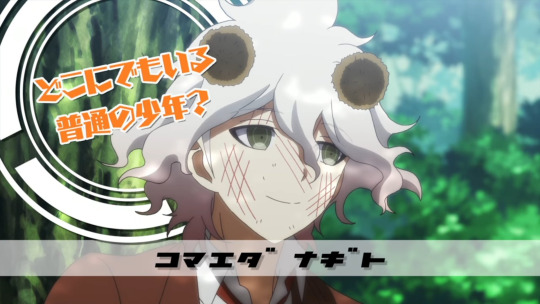
alternate title: what most fans get wrong about komaeda nagito
if you're not familiar with danganronpa 2.5, you should be! it's a 25-minute ova and the whole thing is free + subtitled in both english and spanish on youtube. go watch it!
have you watched it? okay, cool. for those of you who haven't seen it in a hot minute, i'll give a brief summary.
analysis under the cut!
(if you like my analysis, please consider reblogging it!)
part one: the summary
danganronpa 2.5 follows komaeda living in an alternate world where hope's peak is a normal high school and komaeda is an ordinary student living an uneventful life. the only thing exceptional about him is that he has a streak of bad luck (more on this later).
we follow komaeda through an average day at school. after some wacky luck hijinks, he goes to class and hangs out with kuzuryuu and souda. slice of life moments interspersed with komaeda monologuing about his outlook on the world ensue.
then, we see a shot of world destroyer (an alter-ego program of hinata/kamukura) standing on a building overlooking the city. he confirms that this world is the "lowest stratum," and then vows to destroy it. we'll explore what this means later!
we cut back to following komaeda, who is now suddenly at souda's funeral. kuzuryuu gets news that souda was murdered. kuzuryuu, pekoyama, and sonia all leave to find the killer and avenge souda. komaeda protests, saying it's too dangerous. the trio doesn't listen to him.
kuzuryuu, pekoyama, and sonia all find world destroyer and attempt to kill him. world destroyer tells them about his mission and then kills kuzuryuu and sonia. pekoyama calls komaeda to tell him that world destroyer is after him before being killed as well.
world destroyer takes the phone. the sound of hinata's voice causes images of the events of sdr2 to flash in komaeda's mind-- specifically images of jabberwock island, meeting hinata for the first time, and his own death in chapter 5. world destroyer then promises to continue until komaeda's whole world has crumbled.
komaeda immediately leaves to go find world destroyer himself. he finds him in an abandoned building where they talk about komaeda's worldview, where he expresses disdain for the concept of talent (and by extension, world destroyer).
komaeda knows he can't kill world destroyer, so he vows to take him down with him instead. komaeda throws a ball at the wall. his luck causes the ball to ricochet and knock all the screws in the building loose. komaeda then pulls out a gun and fires it at the wall, trusting that the bullet will ricochet both to kill himself and cause the building to collapse. it does.
world destroyer comes out unscathed. komaeda stands back up from the rubble, now wearing his outfit from sdr2 instead of his hope's peak uniform. world destroyer confirms that this had all been taking place in the neo world program. he also confirms that this reality was the lowest stratum of komaeda's subconscious, created as a defense mechanism against the traumatic circumstances of his death. komaeda rebukes the worldview he'd expressed in the program and says it was a world worth destroying.
outside the simulation, hinata is waiting for komaeda as he wakes up. komaeda takes his hand and greets the rest of his class. he proclaims that he'll work toward the future in the name of hope... but not before admitting that the dream he woke up from wasn't a bad one.
wow! what a doozy, right? there's a lot to dig into here, so let's get started!
part two: the lowest stratum
it'll be important going forward to keep in mind that this world represents the deepest part of komaeda's mind, unburdened by hope, tragedy, and denial.
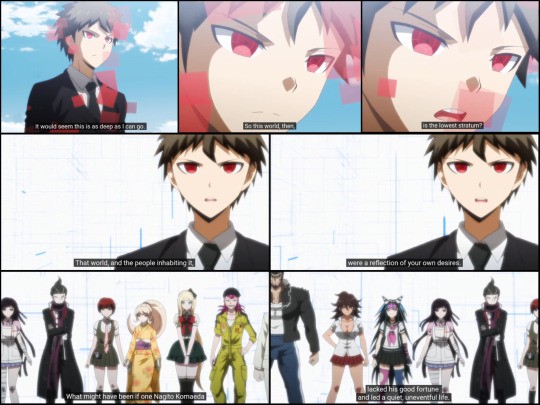
this world is created by komaeda alone. it is a reflection of his most deeply held beliefs and desires. this is stated outright by world destroyer. given the fact that he's an ai built solely for psychodives with no motivation to lie, it's safe to take this as truth.
got it? cool! then let's move on to...
part three: luck
in this world, komaeda's luck works differently. instead of having extreme good + bad luck which hurts those around him, komaeda has only bad luck. this results in the people around him reaping the benefits of the good luck.
this goes to show that komaeda's desire to help other people is a genuine one. he doesn't mind how much misfortune he faces so long as it means the people around him are happier.

in the real world, komaeda isolates himself to protect others from his luck-- his bad luck targets others before it targets him. this paired with his obsessive demeanor means that he's spent his life in the real world unbearably lonely... so it makes sense that his ideal world would be one where he doesn't have to worry about causing the deaths of others.

here, he has friends who he feels secure spending time with-- and they care about him even with his eccentricities. komaeda was honest when he said his deepest desire was companionship and love.
part four: happiness
a major theme in dr2.5 is komaeda's view of happiness. rather than chasing an ideal of hope, komaeda's ideal world is one where people are just leading happy, fulfilling lives. however, he's more focused on the happiness of others.

here we see komaeda's unique outlook-- being the narrative foil of hinata, who sees significance as the key to happiness, komaeda is the exact opposite. komaeda frequently refers to himself as a "nobody" in this ova. of course this is due in no small part to his low self-esteem, but it actually points to a more important piece of komaeda's character: he finds security in remaining unimportant.

remember that this is the deepest stratum-- this isn't denial or self-deprecation. komaeda's luck in the real world has taught him that it's dangerous to get involved. it's easier to find happiness as a "nobody."
what komaeda says next leads nicely into the part of the analysis we've all been waiting for. let's talk about...
part five: talent
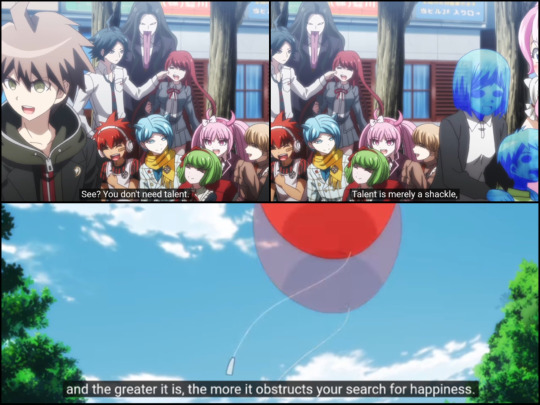
danganronpa 2.5 tackles komaeda's true feelings on talent more explicitly than any other piece of danganronpa media. if you take komaeda's words in sdr2 at face value, it's easy to assume that he values talent over almost everything else.
that assumption is wrong.
in the real world, komaeda has tricked himself into devotion to talent because he needs something to believe in. it helps him justify his misery ("someone as worthless as me must deserve it!") and gives him something to cling to that he believes his luck can't ruin.
but in truth, komaeda resents talent. he hates it. in this ova, komaeda sums his own feelings up perfectly:
"if only the world were free of talent. i despise talent. were i able, i would erase all talent from the world entirely... without talent, everyone would be able to lead modest lives, find a modest amount of happiness. don't you think that would be wonderful?"
he repeats this monologue, almost verbatim, three times.

they're REALLY beating you over the head with this one so you won't miss it. in the deepest stratum of his mind, komaeda hates talent. he wishes it didn't exist at all.
and it makes sense, doesn't it? not only has the tragedy proven to him that talent isn't infallible, but it's also a symbol of his pain. he never really admired talent. he admired the image of something that could never waver. after a life full of tumult where happiness was out of reach, he craved the stability that such a black and white worldview could provide him. he needed some reason, any reason, to give his life purpose. he couldn't accept that all of his suffering was meaningless.
the world, the same world that pushed another teenage boy to see himself as so worthless without talent that he would sign his body away to get it, gave komaeda an easy answer. talent is hope. komaeda latched onto it, and he latched on hard...
but komaeda is smart and rational to a fault. deep down, he always knew that talent wasn't synonymous with happiness. he just lied to himself because it was the only reason he could find to keep himself alive. in the lowest stratum, the world he created for himself, he was safe. he didn't have to lie to himself anymore. that's why he was finally able to express his true feelings of disdain for talent.
but of course, in the world of danganronpa, hope and talent are synonymous. so what about..?
part six: hope
all of komaeda's resentment toward talent holds true for the concept of hope, but with a slight caveat: hope is far stronger a force than talent.
in komaeda's lowest stratum, the concept of hope is one that he's barely even familiar with. hope is something that's too muddled for komaeda's subconscious to fully accept.
on the one hand, it's just another aspect of the obsession he used to keep himself afloat through all his pain. another symbol of heartbreak. another lie he tells himself.
on the other hand, the concept of hope itself isn't a bad one. in the world of danganronpa, true hope divorced from talent IS a force for good. it CAN meaningfully combat despair. it DOES lead to happiness and stability-- the things we know komaeda truly values.
this is why we see komaeda willing to give hope a chance inside the lowest stratum. while he doesn't believe in the false hope he had been feeding himself his whole life, he knows that true hope is still worth believing in.
this also serves as a resolution to komaeda's role as a dark mirror of naegi. where naegi represents the good that comes from an unwavering belief in hope, komaeda represents how it can go wrong when pushed to its limit. acceptance of true hope for its own sake, divorced from the twisted meaning given to it by society, is the natural conclusion of this.
part seven: the end
but if all i've said about komaeda hating talent and needing to separate it from the concept of hope is true...then what about the ending?
if komaeda truly resents talent and values happiness and stability above all else, why does he deny this when he escapes the simulation? why does he insist that those ideas were worth destroying? why does he revert right back to his old point of view, where hope and talent are synonymous and valued above all else?
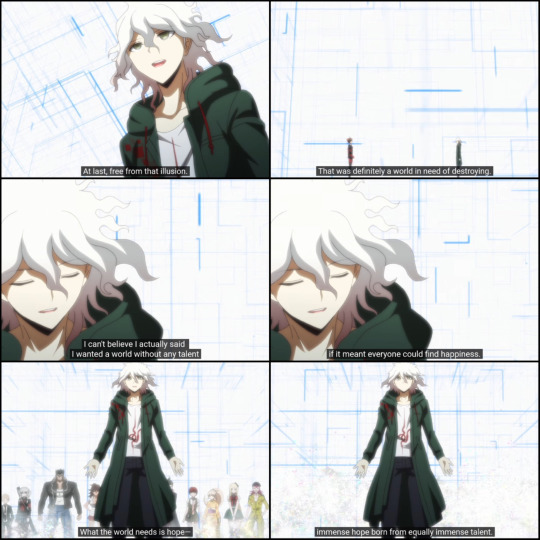
the answer is simple: this is no longer the uninhibited komaeda of the lower stratum. the change in outfit is significant-- we're no longer seeing a representation of komaeda's deepest beliefs and desires. now, we're seeing all of him as he exists with the burdens of his trauma.
he's leaving the security of the world where he and the people he loves are safe, and returning to the world that forced him to warp his own beliefs in the first place. of course he's not ready to let his old view go. how can he guarantee that he'll survive out there without it?
he can't. he may never be able to fully distance himself from it.
but now he knows that other possibilities exist. there are other things which can give his life meaning. happiness is not impossible for him to achieve.
komaeda's lowest stratum forced him to face the reality of his feelings.
he tried to deny it.
but in the end, komaeda allows himself to acknowledge that...

#nagito komaeda#character analysis#danganronpa#sdr2#danganronpa 2.5#danganronpa meta#danganronpa analysis#new tab#tab does analysis#meta
141 notes
·
View notes
Text
Oh I'm a sucker for content about Makoto perpetuating the cycle that caused the apocalypse in the first place because it's whats been expected of him and taught to him, like at the end of dr3 anime how he becomes the principal of the same establishment that did HORRIFIC human experimentation and perpetuated a system that crushed anyone deemed ordinary under its weight. The school ends up taking no blame for its very real and intensely horrific acts because they simply blame despair for it, so of course now that the Ultimate Hope is running it that means all the despair is gone and now Hope will happily shine again. Neatly sweeping under the rug the covered up murders and torture done in the name of that hope before. It wasn't the system, it was a few wildcards, trust the system Makoto, it's all you've been told works isn't it? Society has to have Hope's Peak Makoto, the two are one in the same isn't it?
In the end his title of Hope and the expectations forces him into the same blindfold of "for hope" that allowed Izuru to exist. All he knows and really is allowed to know thanks to future foundation is that he is Hope and has to make more Hope and that as such Hope's Peak must exist as a symbol of that Hope. Which is why when I write post danganronpa 3 content and acknowledge the canon of "he principal now" I have characters who actively oppose and fight against the re-installment of such a system because it's just such a bad idea but the propaganda and hope worship is so intense Makoto doesn't even consider how it might not be a good idea.
Hope and Despair are just so entwined you cannot be an ultimate hope without understanding and being able to use ultimate despair. The two concepts are so twisted together that Junko can cause massive hope if she chooses (ie warriors of hope) and Makoto can create great despair (accidentally letting a second killing game happen thanks to his illegal terrorist rehabilitation program) not to mention hope to one is despair to another, and there really is no way of predicting which way the pendulum will point to until after the act of potential hope OR despair is taken. Ultimate Hope? Ultimate Despair? The talents are one in the same at the end of the day. Anyone deemed to be an Ultimate Hope is one thought of "greater good" away from the next Tragedy. Makoto is no different, and the system will inevitably push his morals to that point if no one intervenes.
#once again i do not blame kyoko for this she definitely had no clue how much her funny little joke would fucking spiral#danganronpa meta#danganronpa 3#trigger happy havoc#makoto naegi#hope's peak academy#danganronpa trigger happy havoc#ultimate hope#ultimate despair#this is so rambly but i juust#makoto is a neat character! hes so good but also so blind in a lot of key ways!#hes been pushed through one hell of a propaganda tunnel and given way too much power!#so he makes a lot of bad choices with good intentions!#i want to see those bad choices called out and explored!#makoto is good but he struggles with realizing that just because he is good and can do good with a system doesnt make the system itself good#my dr lore#this has been three am thoughts
92 notes
·
View notes
Text
As an enjoyer of Komaeda, Hinata, and Kirigiri, Amami really stood out to me on a first playthrough of V3. Mysterious amnesia? Check. Laid-back, helpful personality with underlying sinister vibes? Check.
Sprite siblings with Komaeda? Check.
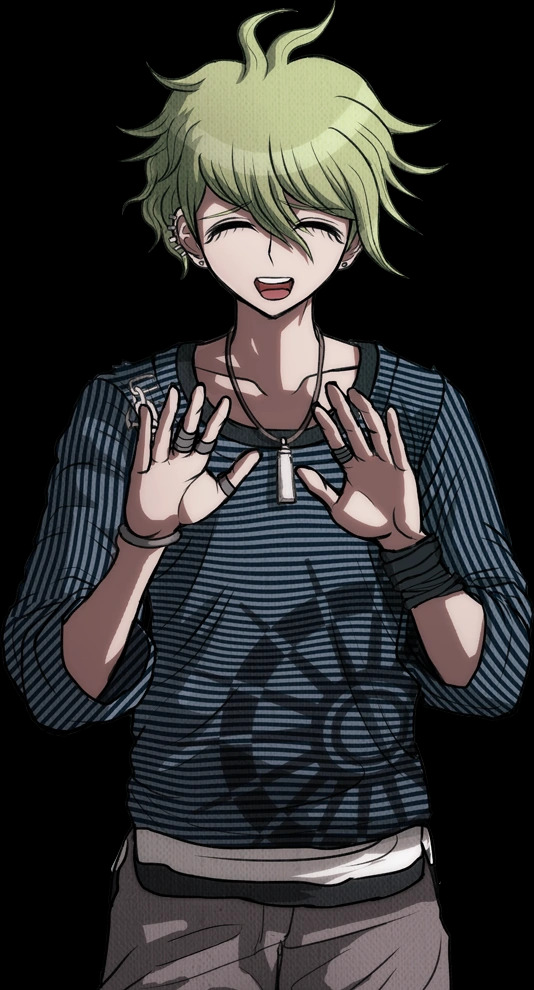


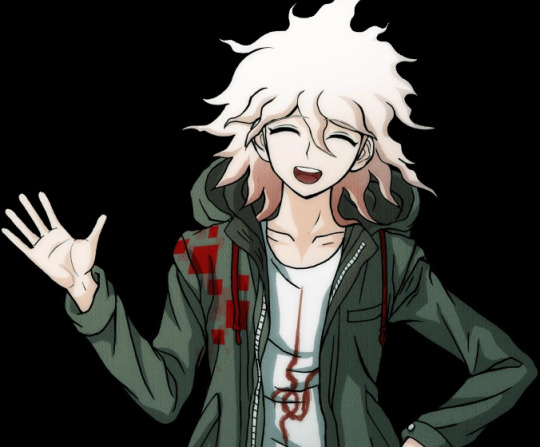


I'm guessing he was written that way as a bit of misdirection: I've seen people react to him by saying, "Okay, either he dies instantly because they're messing with us, or he survives to the end." He comes off as Narratively Important (tm), and unfortunately for him, it turns out you don't have to survive to be Narratively Important.
But, if he did survive, I think it would have been hilarious if his Komaeda parallels/apparent Narrative Importance turned into a running joke.
"Hey, Amami, how did you manage not to get hit by the debris from that collapsing ceiling?" "Huh. Guess I'm just lucky."
Amami being Suspiciously Missing during multiple murders. Turned out he just had his headphones on when the body discovery announcement rang.
Amami always looking like he Knows Too Much about plot developments, but it turns out that's just what his face does when he's confused.
Amami saying something about how people get stronger from surviving hardships, and every player in a ten mile radius going, "OhhhHH if you say 'stepping stone for hope' I'm throwing you to the Exisals."
Amami spending time with Ouma before his big "mastermind" turn, but it was just because he thought Ouma seemed a little down and wanted to cheer him up.
Shirogane: "But you? You weren't supposed to make it this far. You weren't supposed to make it to the end!"
Amami: "By all accounts, it doesn't make sense. :)"
#danganronpa#danganronpa v3#danganronpa v3 spoilers#rantaro amami#ndrv3#danganronpa meta#long post#ndrv3 spoilers#v3 spoilers
8 notes
·
View notes
Note
If you're in the mood for an "essay": 💪! Maybe about you and Kotoko? :D
💪 Describe a theme or other element of the original source material that you feel is strengthened or reinforced by the presence of your ship.
One of the major themes of Ultra Despair Girls is the destructive weight of 'Talent'. People who are considered talented are exploited, hurt, abused, and destroyed by a system where only those who are 'special' succeed , and everyone else is nothing more than some drone.
Gifted Child Treatment x1000, combined with the legitimately horrible and abusive things people can do to try and force their children to be those special 'talented' . This is of course reflected in Hope's Peak, which is a criticism of both irl school and societal behavior, and in universe...a horrifying science experiment devouring children for it's own agenda. (The Izuru Kamukura Project and it's obsession with 'Hope' and superhuman talent).
Kotoko had been hurt more than most, like the rest of the Warriors of Hope, and treated horrifically by her mother from a young age. The Warriors of Hope are a product of the society Hope's Peak fostered, and you see constantly throughout how badly it effected each and every one of them. So they lash out against it, to try and bring it all down and take out the adults who've hurt them.
Meanwhile, Komaru (me :3) isn't talented. She's one of society's write offs. a 'thoroughly average' girl, who's personal desires, hobbies, and goals are all mocked throughout for being 'dull' 'average', 'normal'. Mocked for being scared of death, for liking manga or wanting to be an artist. She's not an adult, not yet, and not anyone Hope's Peak and Co see any worth or value in.
Someone who's brother was chosen at near random to 'ascend beyond' the '''average''' life society had given them. Who'd survived a deadly killing game. Who'd been placed (against his will) on a pedestal as an 'Ultimate Hope'.
Komaru feels lost and helpless in a world that considers her just another face. Kotoko is hurting and angry at a world that treated her with violence in the name of Talent.
When they find eachother, even on opposite sides of a conflict…Komaru feels an intense sympathy. In this ship, Komaru has heard everything that happened to Kotoko and her friends, and is horrified and desperate to help.
Kotoko especially, she feels a deep affection for, at first in a 'big sis Komaru' type way, with a growing romance from there. Komaru sees her as more than the talent horrible people foisted upon her, and Kotoko reminds Komaru that sometimes a little kindness and warmth is better than any label slapped on you from some stupid school or job.
Together, they find that middle ground between Hope and Despair. Talent isn't everything, and you are more than what exploitative bastards say you are. They're their own people, and they have love. affection for eachother, and with the Warriors of Hope, the Towa Trio (Toko, Komaru, Byakuya), and beyond.
I just think it really drives home that central theme that Talent isn't everything, and people can slowly heal from adversity with the support of someone who cares and understands.
#🌟🌺#ask answers#danganronpa meta#hopes peak academy#kotoko x komaru#komaru x kotoko#komaru naegi x kotoko utsugi#kotoko utsugi x komaru naegi#komasugi
10 notes
·
View notes
Text
Every time I watch a new Danganronpa let’s play (this time, it’s YaBoyRoshi), it becomes more and more painfully obvious that Kyoko Kirigiri should’ve been the protagonist. I mean, I get why Makoto was the lead. He’s your typical, loser anime MC who can only talk about how average he is. But for a detective game, wouldn’t it make sense to play as the actual detective?
This also makes the trials awkward to watch. Makoto has to piece everything together when Kyoko already has everything figured out. Instead of just saying what she needs to say, for some reason (coughgameplaycough), she wants Makoto to speak for her. So, if the whole point of the trial is to piece together the mystery, why not play as the character who is trying to piece things together? Makoto just ends up being a middleman to the real detective.
I mean, I still like the series, but it really didn’t age well.
#danganronpa#danganronpa trigger happy havoc#danganronpa thh#anime#video games#makoto naegi#naegi makoto#kyoko kirigiri#kirigiri kyoko#dr kirigiri#danganronpa kirigiri#dr1 naegi#dr1 kyoko#ultimate detective#ultimate lucky student#spike chunsoft#danganronpa meta#dr1 makoto#dr1
13 notes
·
View notes
Note
How about their color theory?
Are...are you asking me about the color theory of the survivors?
Uhhh

You'll notice a lot of green, orange, and purple in these designs, while the intensity varies it does form a bit of a triadic
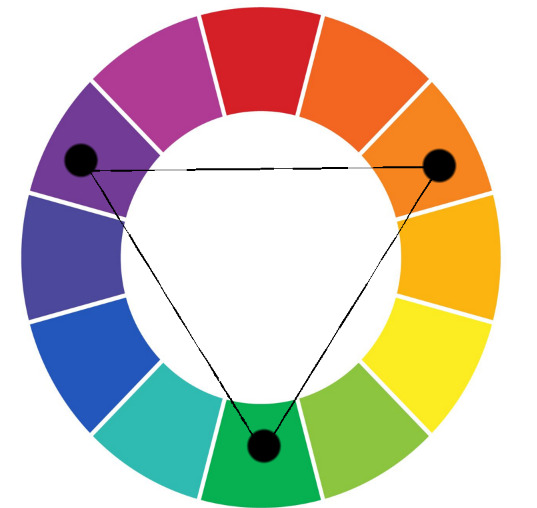
This helps create a sense of harmony between most of the survivors, they look like they belong together which helps show their unity as a group. However, one character as you notice, does not fit

That character, is Aoi. Aoi has no green, no purple, and has a vibrant red and blue. While other characters, and by other characters i just mean makoto, have some red accent to help accentuate the design, Aoi just straight up stands out from how not like the others she looks. Her color scheme is all wrong when compared to the rest of the survivors, this serves two-fold, it's in character for her to dress in a way that stands out like this, she likes to win after all. Plus it help visually shows that Aoi is a bit different from the rest of the group, while the others grew closer together, Aoi while coming together in the end, for the most parts drifts away from everyone, going through a more negative character development.
While Kyoko also stands out a bit more because of her more pastel colored hair, Aoi just straight doesn't look like she belong. Which is really interesting! Her sharp red and her having the only blue clothing just cements her as more of an outsider!
You'd expect if Danganronpa wanted a group to be complete harmonious we'd get a design more like Chihiro to survive over Aoi but instead Aoi someone who is at worst maybe even clashing survives, which makes sense when you remember how much Aoi morally degraded over the course of the killing game, and it's a SHAME that Aoi is so well set up to be a recurring problem or even foil to Makoto but she never gets to do anything!
#trigger happy havoc#musings from the music manager#aoi asahina#anon chaos#trigger happy havoc meta#danganronpa meta#meta
24 notes
·
View notes
Text
the era of Throwaway Fandom is not for me, man. a lot of folks' hyperfixations move too fast by far these days. by the time i sit down to watch Life-changing Anime or Magnificent Film of 2023 you're all nine fandoms ahead and no one wants to discuss it or look at fanart or fanfiction. media's gone TikTok in every regard: to be consumed, obsessed over, memed, then tossed aside for the next slide-down video
707 notes
·
View notes
Note
sorry if this comes off as rude or in bad faith but i'm interested in hearing your reasons on why you dislike saiouma? again, not trying to be rude, i'm just interested since it's one of the big popular ships and i think you have interesting danganronpa takes
@crowssoul2 sent another ask with the same idea, so allow me to respond to them both here instead of trying to cut an essay in half.
Nah! You didn't seem rude at all! I am more than happy to overanalyze Danganronpa, since I love Danganronpa to death. I am just as happy to be asked what I thought they failed @ then to be asked what I liked. Hell, I'll even enjoy civil discussion about why you disagree with my takes. (except maybe my take on the great Chihiro discourse, since bystanders always get pissy at that one)
Also, to preface this, this is a ship and let ship blog. I'm glad all you Saiouma shippers are having fun. Also, I love all the ship art you make. If you enjoy what we got, this isn't a personal attack. Honestly, I wish I were one of you since there's so much more content that way.
I feel like I dislike Saiouma because their canon dynamic went against the themes of the work. Kokichi, as a character, represents lies, which is one of the major themes of Drv3. (The same way Makoto represents hope and Junko represents despair) This seems really obvious to say, but is important to my point. A characters relationship with Kokichi should mirror their relationship with lies.
A good example of this done right is Kaito. Listen, his writing irks me, but his relationship with Kokichi is one of my favorite things about him. (Still can't get behind Oumota bc of Kaito's personality, but that doesn't mean I dislike the foils OR the shippers)
Kaito pretends to hate lies, as heroes should. But his heroic personality is in fact, a lie he tells. Not out of malice, but because that's who he wants to be. (Think Kaito:Hero as Gundam:Dark God) He lies to protect people, and hide his illness. As a result, he's willing to work with Kokichi to... protect Maki, conceal his identity, (which includes hiding his illness) and from a certian POV, be a hero! It makes perfect sense.
Another good example of this is Maki. She hates Kokichi, because she hates lies. Her hatred of Kokichi is actually tied to him revealing one of her lies, a lie that was causing her quite a lot of stress. But... she also directly benefits from Kokichi. He saved her life. Unrelated tangent (sarcasm), what was revealed to be a lie in Ch6? Her feelings for Kaito. Let me rephrase that sentence: She hates LIES but she also directly benefits from them (her feelings for Kaito improving her mental health)
I wish that theme carried over into other characters the same way it did for those two. There are some other parallels I can draw (Ryoma liking Kokichi to an extent, Kirumi playing tag with him) but those two are the most obvious and explicit.
So its sad that characters with a complicated relationship with lies don't also have a complicated relationship with Kokichi, the embodiment of lies.
Himiko lives a lie. Lying is needed for her job. But her lies almost got her killed in chapter 2, and Tenko going along with her lie doesn't help. How does this reflect in her interactions with Kokichi? It doesn;t.
Kaede lied to us, the motherfucking audience. Honestly, thats arguably just as impressive as Kokichi ever pulled. What is her relationship with Kokichi? Kokichi acts sort of like a mentor figure to HER in the tunnels, and stands up against her. I like that, but give that plot beat to someone else. (Kaito makes the most sense, but give it to Tenko since I love her.)
Danganronpa itself is a lie, a work of fiction. And Tsumugi is obsessed with it.
In fact, this applies to the v3 casts dynamic with Kokichi as a whole. Almost everyone dislikes and distrusts Kokichi, despite the big reveal of being liars themselves. I'd write it as "everyone pretends to hate Kokichi (lies), but actually don't mind him that much. However, they think everyone else hates Kokichi so they go along with the group." to foreshadow the big reveal that they themselves are lies told by Tsumugi.
And Shuichi suffers from this the most.
Shuichi's Ch1 arc is summed up by "Shuichi learns to face the truth for the first time with that case, and stops averting his eyes." In other words, on the Truth vs Lies scale, Shuichi begins the series aligned with LIES.
The rest of the game shows Shuichi gradually becoming a paragon of Truth to go against Kokichi's lies- ONLY FOR IT TO BE REVEALED IN CH6 THAT HE HIMSELF IS A LIE.
That he is, a fictional character and a pawn in someone elses game. It then becomes a Schrodinger's cat on the alignment scale I mentioned earlier. Was Shuichi's journey to the Truth end of the scale fake or not?
The game settles upon a hesitant no at the end of it, (I disagree, since the games mechanics tell a different story) when Shuichi ventures out into the world with the other survivors to find the truth upon whats out there.
Thats a HECK of a complicated relationship with lies. It should equal a heck of a complicated relationship with Kokichi, right? WRONG.
The canon Saiouma dynamic is basically
"Kokichi likes and teases Saihara, while Shuichi is annoyed by Kokichi until his death, when he gradually begins to come around. Despite this, Kokichi (and the lie mechanic) is surprisingly helpful in trials"
(actually the localization changed this quite a bit, but I'm going off the English version since this is what I actually played. That being said, its a fascinating topic that you should look into if you're as obsessed as I am.)
While the fanon is more akin to:
"Shuichi gradually gets drawn in by Kokichi and learns to accept his quirks."
(maybe shippers will disagree with me about those dynamics, since again, not my cup of tea.)
Meanwhile a Saiouma dynamic I can get behind is:
"Shuichi is drawn in by Kokichi (lies), and feels a sort of magnetism to him. But he knows it isn't a good idea, and he knows it isn't right. Kokichi's feelings are unclear at first due to his nature, but it turns out he has a love-hate relationship with Shuichi (truth). He'll rely on him sometimes, but rebuff him at others with seemingly no logic from his end."
In other words, I'd do a semi-reversal of the canon dynamic.
NOTE: I am not saying I'm a writing genius or anything. Hindsight is 20/20, and I'm sure if Kodaka could magically remake his games he'd stomp my rewrite to the ground.
You asked why I dislike it, and that's my explanation. But please allow me to go a step further and speculate why things are this way.
At about the same time you sent me your ask, my good friend Crow sent me this:
"I don't like Saiouma because well Komahina is exactly what the black romance should be while Saiouma is just feels like another Shuichi ship. Do you get my point?
Shuichi and Hajime is entirely different characters while Komaeda and Kokichi different af too like, they can't hit the Komahina dynamic like they intended to do, this is why Saiouma is just another Shuichi ship while Komahina is THE SHIP.
If you want to do a homoerotic Shuichi ship who would be the next Komahina you shouldn't do that with Kokichi at all, maybe Rantaro? But Rantaro isnt work well too like there is no Komaeda for him to work the Komahina. Saiouma felt poorly executed idea of a black romance, if I need to be honest Oumaede would be more fitting for the Komahina dynamic despite Kaede is just pov character.
So yeah there is no Komahina in drv3 because they tried to play the same tropes with very different characters and very different stories, I even felt more interested in Saihoshi despite Ryoma only been around 2 chapters than Kokichi. That is the problem in here"
I felt like I can't answer one of these asks without referencing what I said in the other ask, so I just both answered them both together. (no hard feelings?)
In case you haven't read Homestuck (wise call, honestly) Black romance is basically non-sexual hatefucking. Usually, there's an undertone of mutual respect, but not always. Felt like that context was important.
Komeada and Kokichi ARE different characters. From a narrative standpoint, Komeada completely turns existing themes like Hope and Talent into complex issues in the Drverse, while in THH they were pretty black and white. Meanwhile, Kokichi's introduction is the introduction to the theme of truth vs lies.
In other words (Makoto is to Nagito (and later to Hajime and Izuru) as Kokichi is to Shuichi) The second takes the theme from the first, and massively expands on it! ...Despite Shuichi and Kokichi being in the same game.
Despite this, the reason people think they are similar is because Kokichi piggybacks too hard on Nagito and Komahina's success.
What does Nagito have in common with Togami, other than being an antagonistic force. Not much, actually! Togami fucked up a corpse while Nagito fucked up his own body, and that distinction is all that needs to be said I think.
Togami would look down upon Nagito if they ever met, and Nagito'd be into that.
What does Kokichi have in common with Nagito?
They want to make an unsolvable murder in which poison was involved and they got someone to kill them.
They both have a one sided crush on their protagonist, that the protagonist doesn't think exists. (Kokichi confessed, but perks of being a chronic liar)
They both are the MVP in almost every trial they are in, with one notable exception for each of them.
Thats... kind of a lot, actually! I do think they are noticeably different characters, especially on a thematic level, but I can see why people notice that. I can also see why people would find that bad! Nagito was the star of Dr2, hands down. If you were one of the few people that isn't a total Nagito simp, then a very simmilar character getting screentime might be annoying since you have Nagito fatigue from the last game.
and if you are a Nagito simp, then Kokichi will likely never be his own dude with so much in common. You'll see him as a lesser Nagito and want him back.
I agree with Crow when he says "Saiouma just feels like another ship. I found it hard to articulate why I feel that paradoxically feels like a rip-off of another ship I liked, but also had no bite to it.
And then it hit me. Until Chapter four, Kokichi never did anything that warranted Nagito levels of hatred.
(of course, this is entirely subjective. I hate Kaito pretty much for being annoying and fitting into tropes I dislike without commenting on it. If you think this is enough to hate Kokichi, power to you!)
By the end of chapter one of Dr2, Nagito:
Attempted to 1st degree murder a fan-favorite character, with a deliberately confusing and unsympathetic (at this point in time) motive to do so.
Goaded another character (that most fans hated, but still) into committing that murder FOR him. The only time we ever saw that level of insanity was Celeste, and Teruteru is no Hifumi in terms of gullibility. (Celeste had plot armor anyway.)
Sat back and monologues while everyone's ass was on the line. If Hajime and the others voted wrong, everyone would have died.
Showed NO remorse over any of it. Seemed to enjoy it.
This one is more meta but: he shows despair eyes, which previously were only seen on the big bad of the first game.
Characters have every reason to hate the guy. Soda and Nekomaru were absolutely correct in taking him out, and I'd argue that you should maybe go father by putting him in a public area and gagging his mouth unless it's mealtime.
Meanwhile, by chapter three, Kokichi has:
Stood up to Kaede in the tunnels, which most students agree was the right call.
Showed emotions over Rantaro's death, but due to his lying they can't be sure if they were genuine.
Was civil (if a bit wierd) to Kaede right before her execution.
Bullied Kiibo. Yes, bullying is- bad but look me in the eye and tell me its worse than murder. You can't.
Shared the motive videos in the insect meet and greet. This is the major strike against him, but its reasonable to assume he did this with good intentions.
While doing that, tortured them with bugs when it wasn't really needed for the plan to work.
(okay, this one didn't actually happen and I will die on this hill, but the main group thinks it did so I'm counting it) Tricked Gonta into helping with his plans.
Saved our asses in the second trial.
Saved our asses in the post-trial portion of chapter 2
Not joined a cult that was forming in our school. Also did not stop Gonta from joining the cult, which doesn't point to a pattern of controlling behavior from Shuichi's POV.
Was key in getting to Angie's body. Pun intended.
Helped out during the seance.
While arguably not the MVP in trial 3, he still contributed a great deal.
Do those lists of crimes seem equal to you? It takes Kokichi 3 chapters to do something that is, at most, Hiyoko level. Maybe Byakuya level, but thats pushing it.
Yet, the characters treat Nagito and Kokichi with about equal annoyance and disdain. The v3 cast, of course, doesn't know that Nagito exists. But we, the players, know.
Its like we got prologue Nagito for almost four chapters, but prologue Nagito was also kind of a bitch? But also possibly well-meaning and OP as fuck.
This concludes my analysis! Do you agree? Disagree? I'd love to hear thoughts.
#ask tag#crowtalks#danganronpa#danganronpa meta#kokichi oma#kokichi ouma#danganronpa analysis#danganronpa essay#shuichi saihara#drv3#nagito komaeda
34 notes
·
View notes
Text

danganronpa + evangelion bootleg
5 notes
·
View notes
Text
Since the post about differences in translation in regards to Kaito and Kokichi's relationship was unfortunately deleted, I've taken it upon myself to make my own for posterity's sake.
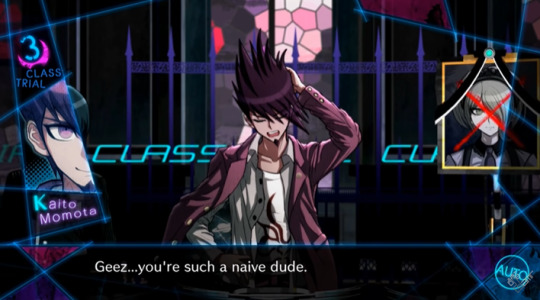
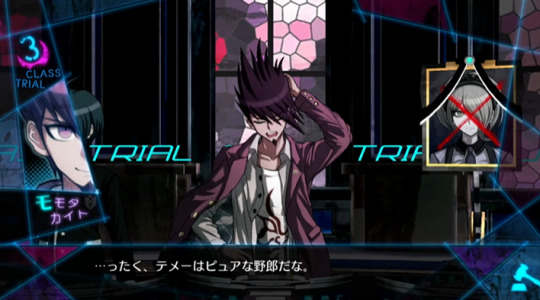
NISA: Geez… you're such a naive dude.
OG: 。。。ったく、テメーはピユアなやろうだな。/ …Geez, you're such a pure guy.
A pretty well-known change that makes Kaito sound more insulting then he does in the original. Kokichi's response was also altered not only in the text, but in the voice acting; in Japanese, he sounds uncharacteristically emotionless, rather than annoyed like in the dub.


NISA: Well, we come from different backgrounds. So for now, let's agree to disagree.
No one's ever called me naive before. And from Kaito? Seriously?
OG: まあ、百田ちゃんとオレの話が合わないのわ最初あきらめているけど。。。 / Well, I'd already given up on seeing eye to eye with Momota-chan since the beginning…
ピュアなんて言われてのわ初めてだよ。オレみたいに嘘つきがさ。/ But that's the first time someone's called a liar like me pure.
Kaito goes from telling Maki to let Kokichi go or he'll die, to telling Maki to let Kokichi go so she won't get executed:

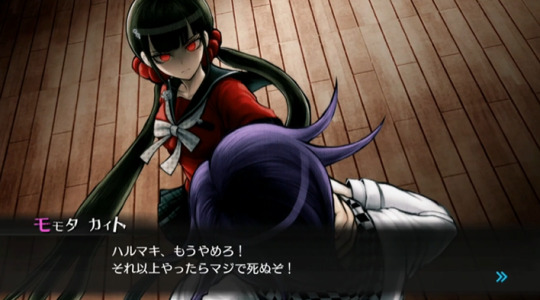
NISA: Maki Roll, cut it out! You'll get killed if you don't!
OG: ハルマキ、もうやめろ!それ以上やったらマジで死ぬぞ!/ Harumaki, stop already! Any more than that and he'll seriously die!
Kaito's response to Maki saying he shouldn't have cooperated with Kokichi is translated to sound like he was pestered into it. In the original, it sounds like he's seriously reflecting on Kokichi's state of mind throughout the game.

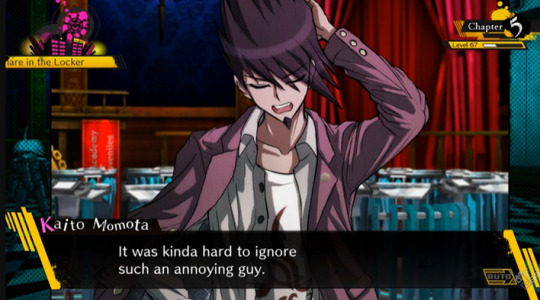
NISA: It was kinda hard to ignore such an annoying guy.
Geez… I wonder how far ahead he planned this evil scheme of his.
OG: 。。。あいつわそんあ易しいヤツじゃねーよ。/ …He wasn't that simple.
まったく。。。どこからどこまでが計算だったんだろうな。あいつの悪巧みわよ。/ Man… I wonder how much of it he'd planned out. For that cunning scheme of his.
And of course, Kaito's final words on Kokichi were made to sound a lot harsher.

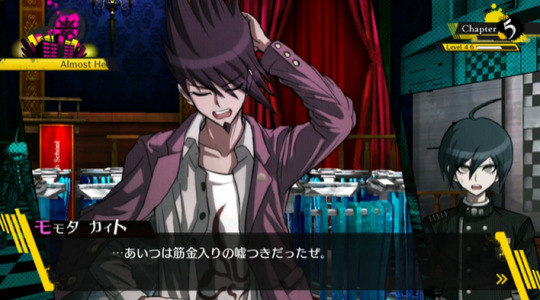
NISA: He was a lying sack of shit.
OG: 。。。あいつは筋金入りの嘘つきだったぜ。/ …He was a liar to the core.
#danganronpa v3#danganronpa killing harmony#drv3#ndrv3#kaito momota#kokichi ouma#oumota#doretalks#meta#translation bs
675 notes
·
View notes